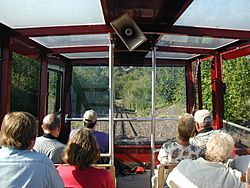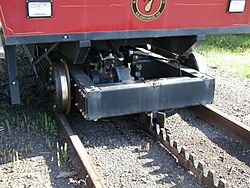Quincy and Torch Lake Cog Railway facts for kids
The Quincy and Torch Lake Cog Railway is a special train track in Hancock, Michigan. It's about 0.8 kilometers (half a mile) long. This railway uses a unique "cog" system to climb steep hills. It opened in May 1997. Its main job is to take visitors to the old Quincy Mine. The tram car can hold 28 people. It can climb very steep slopes, up to 35%. This railway is one of only a few cog railways in the United States.
Contents
History of the Quincy Cog Railway
Mining Days: An Older Tramway
Before the current tourist tram, the Quincy Mine had a different tramway. Miners used it to move copper ore down the hill. This old tram had two tracks. The cars balanced each other as they went up and down. It was about 670 meters (2,200 feet) long. It dropped about 150 meters (500 feet) vertically.
Building the Modern Tourist Tram
Before the new tram, visitors went to the mine entrance by van. This was not very easy. James R. Vivian Sr. suggested building a new tram. He was a leader at the Quincy Mine Hoist Association.
The U.S. Economic Development Administration gave $420,000 for the project. The Hoist Association also raised $200,000. Construction started on April 12, 1996. It was finished on November 11, 1996. The tramway welcomed its first visitors in May 1997.
Phil Quenzi designed the tram car. Royale Construction Inc. built it. MJO Construction laid the tracks. Robert D. Hitch was the project engineer. James R. Vivian Jr. managed the project.
In the winter of 2009, the tram got a makeover. It received new paint and new windows. The seats were also fixed up.
What Makes the Tram Special?
The tram car runs on a 165-horsepower diesel engine. It is about 10.7 meters (35 feet) long. It is also about 2.6 meters (8 feet, 6.75 inches) wide. The tram can carry 28 passengers. It travels at a top speed of 16 kilometers per hour (10 mph) on flatter parts. The tram is made of red-painted steel. It has large windows on its sides and even on the roof. This allows passengers to see great views.



